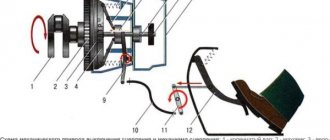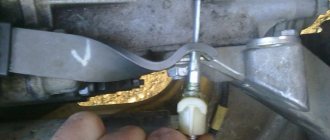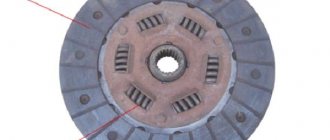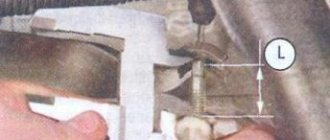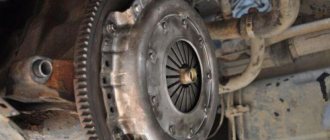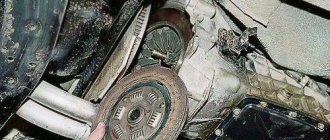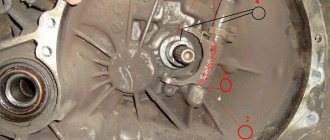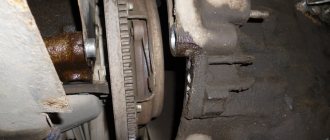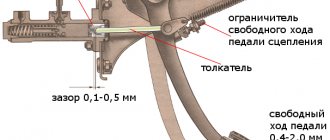12.03.2020
| (Votes: 1, Rating: 5) |
Issues discussed in the material:
- What is a clutch cable?
- Signs of a faulty clutch cable
- How to adjust the clutch cable
- How to change the clutch cable
- What to do if it is not possible to change the clutch cable on site
- Which, according to car owners, is it better to buy clutch cables - original or not?
On vehicles with a manual gearbox, a clutch cable is installed as standard. This is a relatively simple device whose task is to ensure smooth contact of the car with the road surface.
However, there are cases when contact is lost as a result of a break in the specified cable, and then the corresponding pedal simply fails. In such situations, the main thing is to remain calm and get to the nearest parking lot, and you will learn how to change the clutch cable by reading to the end of this article.
What is a clutch cable?
Clutch types can be different. Most often, the designs consist of one or more friction discs tightly compressed with each other (or with the flywheel) using special springs.
The material used to make the cable is similar to that used for modern brake pads. It should be noted that previously this product almost always contained asbestos. Currently, asbestos-free materials have gained popularity.
The constantly rotating drive disk slips relative to the driven one (connected by a spline to the gearbox), thereby ensuring smooth shifting of gears. The crankshaft, which is located in the engine, is connected to the drive disk.
A hydraulic or mechanical (cable or lever) drive, using an appropriate pedal, transmits force to the mechanism.
By pressing the pedal (turning off and squeezing), the cable is activated. During this process, the disks are spaced out, leaving free space. As the pedal is lowered, both discs (driver and slave) can be fully compressed.
It happens that the cable fails (breaks), which ultimately leads to breakdown of the entire mechanism. Sadly, repair in this case is impossible. Therefore, experts recommend completely changing the part.
These simple jobs can be done by a non-professional. You just need to understand a little about the structure of the car and carefully study the instructions.
Signs of a faulty clutch cable
If a vehicle experiences constant loads or is operated in difficult conditions, the cable often breaks. However, such a nuisance can happen to any car, even if the mileage is not very high.
In addition, improper driving leads to rapid wear of the cable. For example, abrupt starting at high speeds. Another cause of breakdown is constant pressing of the clutch while driving, which leads to slipping.
The following signs indicate that the cable is faulty:
- The pedal is pressed hard. If everything is not in order with the cable, the pedal begins to stick. The driver feels resistance as it is pressed very tightly. The cable breaks and the pedal falls under too much pressure. In a situation where the pedal “fell” to the floor, the part must be replaced.
- The clutch slips. A cable malfunction is indicated by the fact that the clutch begins to slip frequently. Slipping is a spontaneous gear shift situation. For example, due to the uncontrolled operation of the clutch mechanism, the car begins to move even when the neutral gear is engaged. Slipping usually occurs as a result of the engine being overloaded, such as when driving uphill or accelerating rapidly.
- No switching. This malfunction can occur when the cable breaks or stretches. This happens especially often when the clutch fails and the pedal fails. The mechanism stops working. As a result, the engine begins to function stationary, despite the gear being engaged. To extend the service life of the cable, experts recommend constantly lubricating it.
We recommend
“Clutch pedal sensor: functions and malfunctions” Read more
- Other signs . Inspect the cable carefully. If there is a leak, this indicates a malfunction. This type of damage occurs as a result of a broken or disconnected cable. If it just comes unhooked, you need to firmly secure it in its original place, otherwise, change it.
If this part does not influence the disks, the car begins to move jerkily and twitch.
How to adjust the clutch cable
The situation when, while shifting gears when squeezing the pedal, it “falls” to the floor, indicates a problem with the cable itself. In this case, you need to be very careful to reach a place on the highway that is safest and where there is not too much traffic, stop at the side of the road and try to find out the cause of the malfunction.
Before starting replacement work, it is necessary to establish exactly why the part failed (whether this happened as a result of a break or simple displacement). If the cable is torn, it needs to be replaced with a new one. If a part has moved, it should be well adjusted.
Some car owners mistakenly think that it is absolutely useless to adjust the clutch cable in a car. They are confident that only replacing it will correct the situation. This is not an entirely correct opinion, since vehicle manufacturers themselves often advise first establishing the root cause of the malfunction, and then starting to replace the old part with a new one. As a rule, in most cases everything can be accomplished by adjusting the mechanism.
Adjustment is carried out using two types of keys. The work is performed according to the following scheme:
- Loosen the locknut slightly. This is necessary to ensure free space for the tension nut to move.
- Then, to achieve the correct degree of tension on the clutch cable, perform several manipulations with the tension nut.
To check the result obtained, press the clutch pedal, thereby finding out how free its movement is.
It happens that even after tightening the cable, the pedal continues to fail. To correct the situation, you need to carry out all the manipulations with the tension nut and locknut again, and then depress the pedal again.
It may also happen that you will have to tighten the cable several times until you achieve a normal degree of elasticity and softness of the pedal. It is very important not to overdo it in this case. After all, too much stretching can lead to the cable breaking. If the tension is less than necessary, the mechanism will not function properly.
It should be additionally noted that car models are produced that are equipped with ratchet cable mechanisms equipped with a self-regulation function. This feature frees the driver from manually adjusting the device, since the length of the cable worn out during operation is adjusted automatically. It is only necessary to systematically check the degree of ease of pedal movement.
How to change the clutch cable
To learn how to change the clutch cable, you need to carefully study the instructions and follow them. Before work, prepare the necessary tools and materials, namely:
- a new copy of the cable (individual for each specific model);
- a jack for lifting the car (it’s better if you find an inspection hole);
- a set of different-sized wrenches;
- Screwdriver Set;
- To finish the drive, lubricant or graphite compound is needed.
We recommend
“Partial oil change in an automatic transmission: advantages and features of this method” Read more
To change the clutch drive cable, you will need pliers.
- Before dismantling the damaged mechanism, measure its free part at the lower tip, located near the gearbox.
- Push the cable forward. Then remove its tip from the hole in the clutch release fork.
- Remove the cable sheath damper located on the surface of the gearbox housing from the mounting bracket.
- Directly inside the car, disconnect the cable end and the clutch pedal.
- Remove the device towards the engine compartment.
- Manipulations for installing a new mechanism are similar to those at the dismantling stages and are carried out in the reverse order.
At the end of the cable installation work, its initial adjustment is made. You need to do the following:
- measure the distance from the clutch release fork to the end of the damper (the distance should be as specified in the instructions);
- determine the size of the interval between the tip of the cable and the end part of the damper (we check the resulting distance with the recommended manual);
- if the dimensions do not match, adjust the device using the adjusting nut;
- check the adjustment (you need to press the clutch pedal several times, then take measurements again: if the results obtained do not correspond to those indicated in the instructions, make the adjustment again);
- When finished, tighten the locknut firmly.
The time you will spend on all operations will not exceed 15 minutes. Be sure, before changing or adjusting the mechanism, read the car manufacturer's tips and recommendations regarding clutch repair. In addition, it is necessary to find out information about the parameters for adjustment.
As a rule, cars made mainly in Russia are equipped with a clutch cable. Foreign companies prefer hydraulics. Of course, there are foreign cars equipped with a clutch cable. However, such machines are rare.
How much does it cost to replace a clutch cable? Taking into account the price of a new spare part, you will have to pay about 2 thousand rubles for the work.
List of online stores selling parts (Moscow, St. Petersburg, Kyiv regions)
| № | Name | Address |
| 1. | "Doka-Market" | doka-market.prom.ua/ |
| 2. | "Ukrparts" | ukrparts.com.ua/ |
| 3. | "Amperavto" | https://amperavto.ru |
| 4. | "Grantauto" | www.grantauto.ru |
| 5. | "How much" | www.avtostore.spb.ru |
| 6. | "Online auto parts store Z24" | z24.blizko.ru/ |
What to do if it is not possible to change the clutch cable on site
If one day it happens that the clutch pedal is “lost,” it means that with a high probability we can say that the cable has broken and needs to be replaced. It is important in this difficult situation not to give in to panic, which will not lead to anything good.
First, calmly turn off the car engine. Turn on the emergency signal. If, after looking under the hood, you are convinced that your fears about damage to the part are not in vain, do the following:
- Sit behind the wheel and engage first gear. It is quite possible to do this even with the engine turned off and the clutch pedal not working.
- Look in the rearview mirror to make sure you are driving safely. Start the engine. The car should jerk forward, making several jerks. You must immediately press the gas pedal to start moving.
There is a chance that you will only be able to drive in first gear. However, if you have some minimal skills, you can change gears even if the clutch is faulty. In this case, you just need to try to catch the right moment. For everything to work out, accelerate to the required speed, take your foot off the gas pedal, and place the shift lever in second gear. To stop, use neutral speed.
In case of a complete stop, you must adhere to some rules. The most important thing is that you should never brake when going uphill, because it will be very difficult to get going, almost impossible. In this situation, the battery will not withstand the attempts.
It is more correct to stop on a flat section of the road or downhill. Of course, the best option is to call a tow truck. Then the vehicle will be delivered without any problems to the desired location, where the part will be replaced, and the gearbox will not be damaged.
What are the conclusions from all of the above?
- If the clutch cable breaks, this is not a death sentence. With such a defect it is quite possible to move on. But the driver does not always have time to catch the moment and engage the desired gear in time, which can cause slight damage to the gearbox itself.
- It’s good if you can get to the parking lot on your own, without outside help. Otherwise, you should stop on the side of the road and think about your further actions.
- Under no circumstances should you stop before going up, as it will be almost impossible to start.
- Immediately after starting the engine, press the gas pedal.
These recommendations can be relied upon in other situations. For example, if the release bearing is damaged and the clutch breaks.
Preparing for work
Initially, it is recommended to find a place where it is most convenient to inspect the car and replace the part. Since you will have to work not only under the hood, but also under the car, the best assistants will be a lift, pit or overpass. If you do not have the opportunity to use one of these options, you can simply raise the car using jacks.
Also, before starting work, you need to make sure that you have everything you need at hand. To replace the cable you will need:
- new part;
- set of wrenches;
- screwdrivers.
On average, you can replace this element on a VAZ-2109 yourself in 20 minutes.
Which clutch cables are better to buy – original or not: opinions of car owners
- The Chinese did not disappoint! “I purchased a mechanical “cartridge” made in China. I paid only a few dollars, I’ve been using it for three years, constantly pulling the clutch. I was pleased with the work of the Chinese. But if you want to change the auto-adjustment cable, I advise you to buy a more expensive, original one. Because the mechanism is not fully thought out and cannot be repaired, in which case it will only have to be replaced.”
- No problems for two years now
“My cable didn’t break, but stuck halfway through the pedal stroke when returning. That's why he kept lifting it with the toe of his boot. I wanted to change it. I studied all the most acceptable options and decided to buy the original. Although expensive, it closed the issue. It's been two years now. There are no problems driving in traffic jams.”We recommend
“Repairing the gearbox rocker: how to disassemble and adjust” Read more
- It’s not necessary once at a time
“The other day I had to change the original of the old version. The breakdown occurred at 390 thousand km. They changed it again to the old original version. So far I'm happy. But a friend has already replaced the originals three times with a mileage of 30–35 thousand km. Here, it seems to me, we’ll be lucky with our modern technology.” - I always carry a spare one with me
“I had to change it more than once, as it constantly broke off after 10 thousand km. One new one even broke after a thousand km. Then the sector completely collapsed. Then I changed it to the original and took the cable from the donor (the donor used 120 thousand km, I don’t know how much before it). Looks like new. The result is crisp gear shifting. At 10 thousand mileage I removed and inspected everything. Despite the fact that everything is fine with the cable, the habit of carrying a spare one remains, in case you have to change it.” - In fact, there is no difference
“I took a non-original one, drove about 30,000 km. A few days before the New Year, I received a “gift” from the car. I was lucky that I was able to exchange it for a new one before the holidays. The price for the original version in almost all companies is approximately 3-4 times higher than for the non-original one. Judging by experience, both options work fine up to 30 thousand km, then they need to be changed. That is, there is no point in overpaying. Of course, the external data of the non-original is worse. For example, the rubber of the cuffs is so thin that it resembles condoms (and even those may be more reliable). And what should you choose? I changed it again to a non-original one. Here chance decided for me, since on December 31st the store only had these in stock. Relatives could only be ordered after January 3rd. This is as Zhvanetsky wrote: “And these are three...but today. And those yesterday were five..., but big..., but yesterday...". But at least I saved money.”
How to change the clutch cable on a VAZ video:
Review of Manufacturer Prices
| Manufacturer, article | Price, rub.) | Resource (Thousand km) |
| Lada 21901-1602210 original | From 634 | 100 |
| ASPCC260210 | From 465 | 75 – 80 |
| BRAND 219011602210 | From 300 | 75 — 80 |
| 21901-1602266-00 | From 150 | 40 |
| 21901-1602210-00 | From 550 – 600 | 75 |
| 21901-1602210-00 | —/— | 75 |
*prices are current as of October 29, 2018.
Recommendations for the selection of parts and components
When choosing components, give preference to high-quality parts with original catalog numbers. Purchase spare parts from certified points of sale, official representative offices, and dealers. To a lesser extent, use the services of unverified intermediaries who sell products at reduced prices. Cheapness is the first sign of a fake.
